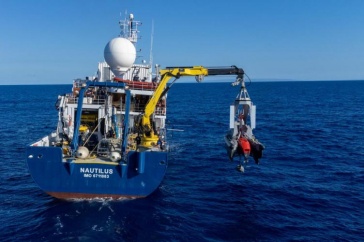UNH Scientists and Students on Monumental Ocean Mapping Expedition in Hawaii

UNH scientists & students are on 23-day seafloor mapping expedition aboard the E/V Nautilus to map one of the world’s largest protected marine areas. They are performing high-resolution mapping & running the autonomous surface vessel, DriX. Photo Credit: Ocean Exploration News
DURHAM, N.H.— Twelve scientists and students at the University of New Hampshire are aboard the Exploration Vessel (E/V) Nautilus as part of a 23-day seafloor mapping expedition in the Papahānaumokuākea Marine National Monument (PMNM), the largest marine protected area under U.S. jurisdiction. The results from this mission will help scientists to better understand the natural and cultural resources of the PMNM, while also contributing to the SeaBed 2030 goal of mapping the world’s seafloor by the year 2030.
“It is remarkable to have a Nautilus cruise with 12 people associated with a single institution,” said Larry Mayer, director of UNH’s Center for Coastal and Ocean Mapping and lead scientist for the expedition. “This is a tremendous example of the broad reach of UNH and its global influence on the ocean mapping world.”
Northwest of Hawaii lies a chain of tiny, rugged islands, massive underwater seamounts and steep escarpments that few humans in the modern era have explored. These geographic features are part of one of the world’s largest marine protected areas, but most of their details have remained unmapped until now.
The team from UNH, which comprises nearly half the scientific crew for this expedition, are working to acquire high-resolution seafloor maps and running an uncrewed autonomous surface vessel known as DriX to map areas where the Nautilus is too large to access and to greatly increase the efficiency of mapping as both vessels independently map at the same time. Scientists and students are working side by side on the ship, taking round-the-clock shifts to collect dual-technology echosounder data from both the Nautilus and DriX.
The expedition is funded by NOAA Ocean Exploration via the Ocean Exploration Cooperative Institute and the NOAA Office of Coast Survey via the UNH Joint Hydrographic Center.
The University of New Hampshire inspires innovation and transforms lives in our state, nation and world. More than 16,000 students from all 50 states and 71 countries engage with an award-winning faculty in top-ranked programs in business, engineering, law, health and human services, liberal arts and the sciences across more than 200 programs of study. A Carnegie Classification R1 institution, UNH partners with NASA, NOAA, NSF and NIH, and received $260 million in competitive external funding in FY21 to further explore and define the frontiers of land, sea and space.
Latest News
-
December 4, 2025
-
November 26, 2025
-
November 6, 2025
-
November 5, 2025
-
October 24, 2025














































